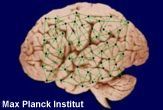Is There Such Thing as Mind Reading
Scientists Say Everyone Can Read Minds

Empathy allows united states to experience the emotions of others, to identify and sympathize their feelings and motives and meet things from their perspective. How we generate empathy remains a subject field of intense debate in cognitive science.
Some scientists now believe they may have finally discovered its root. We're all essentially listen readers, they say.
The idea has been tedious to gain acceptance, simply evidence is mounting.
Mirror neurons
In 1996, 3 neuroscientists were probing the encephalon of a macaque monkey when they stumbled across a curious cluster of cells in the premotor cortex, an surface area of the brain responsible for planning movements. The cluster of cells fired not just when the monkey performed an action, but besides when the monkey saw the same action performed by someone else. The cells responded the same way whether the monkey reached out to grasp a peanut, or merely watched in envy as another monkey or a homo did.
Because the cells reflected the actions that the monkey observed in others, the neuroscientists named them "mirror neurons."
Later experiments confirmed the existence of mirror neurons in humans and revealed some other surprise. In add-on to mirroring actions, the cells reflected sensations and emotions.
"Mirror neurons suggest that we pretend to be in another person's mental shoes," says Marco Iacoboni, a neuroscientist at the University of California, Los Angeles School of Medicine. "In fact, with mirror neurons we practise not have to pretend, we practically are in another person's mind."
Since their discovery, mirror neurons have been implicated in a wide range of phenomena, including certain mental disorders. Mirror neurons may assist cerebral scientists explain how children develop a theory of mind (ToM), which is a child's understanding that others accept minds similar to their own. Doing so may aid shed light on autism, in which this type of agreement is often missing.
Theory theory
Over the years, cognitive scientists have come up with a number of theories to explain how ToM develops. The "theory theory" and "simulation theory" are currently two of the most popular.
Theory theory describes children as budding social scientists. The idea is that children collect show -- in the form of gestures and expressions -- and apply their everyday understanding of people to develop theories that explain and predict the mental state of people they come up in contact with.
Vittorio Gallese, a neuroscientist at the University of Parma in Italia and one of original discovers of mirror neurons, has another proper name for this theory: he calls it the "Vulcan Approach," in honor of the Star Trek protagonist Spock, who belonged to an alien race called the Vulcans who suppressed their emotions in favor of logic. Spock was oftentimes unable to understand the emotions that underlie human being behavior.
Gallese himself prefers simulation theory over this Vulcan approach.
Natural mind readers
Simulation theory states that we are natural listen readers. Nosotros place ourselves in another person's "mental shoes," and utilize our ain mind equally a model for theirs.
Gallese contends that when we interact with someone, we exercise more just detect the other person'south behavior. He believes we create internal representations of their actions, sensations and emotions within ourselves, as if we are the ones that are moving, sensing and feeling.
Many scientists believe that mirror neurons embody the predictions of simulation theory. "Nosotros share with others not only the way they normally human action or subjectively feel emotions and sensations, only also the neural circuits enabling those same deportment, emotions and sensations: the mirror neuron systems," Gallese told LiveScience.
Gallese points out, still, that the two theories are not mutually sectional. If the mirror neuron organisation is defective or damaged, and our ability to empathize is lost, the find-and-guess method of theory theory may be the only option left. Some scientists doubtable this is what happens in autistic people, whose mental disorder prevents them from understanding the intentions and motives of others.
Tests underway
The thought is that the mirror neuron systems of autistic individuals are somehow impaired or deficient, and that the resulting "mind-incomprehension" prevents them from simulating the experiences of others. For autistic individuals, experience is more observed than lived, and the emotional undercurrents that govern so much of our human behavior are inaccessible. They guess the mental states of others through explicit theorizing, but the end issue is a list -- mechanical and impersonal -- of actions, gestures and expressions void of motive, intent, or emotion.
Several labs are now testing the hypothesis that autistic individuals have a mirror neuron arrears and cannot simulate the mental states of others.
One recent experiment past Hugo Theoret and colleagues at the Academy of Montreal showed that mirror neurons commonly active during the ascertainment of hand movements in non-autistic individuals are silent in those who have autism.
"You either simulate with mirror neurons, or the mental states of others are completely precluded to you," said Iacoboni.
Related Stories
- Brain Breakthrough: Scientists Know What You'll Do
- Encephalon Power: Mind Control of External Devices
- Only Using Part of Your Encephalon? Think Again
- Study: Your Encephalon Works Like the Internet
Uplink Your Views
Talk over this or other Human Biology stories
Source: https://www.livescience.com/220-scientists-read-minds.html
0 Response to "Is There Such Thing as Mind Reading"
Post a Comment